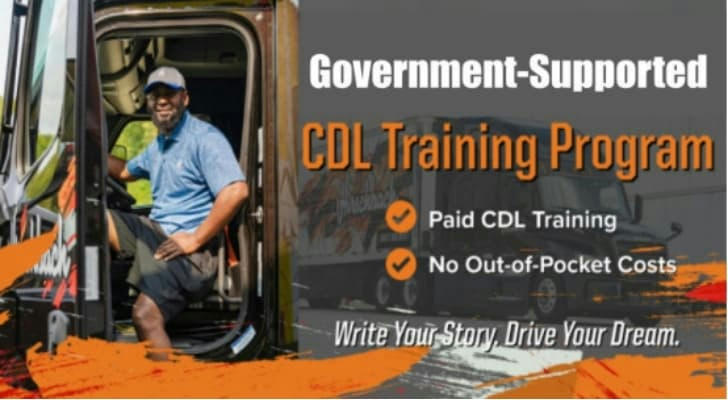Low-Burden Guide to Obtaining a Commercial Driver's License (CDL)
The trucking industry is a vital pillar of logistics and supply chains, with a growing demand for CDL-certified drivers. Particularly in the United States, the severe shortage of drivers has created excellent employment opportunities for professionals. CDL training is a crucial pathway to becoming a qualified truck driver, helping learners master the skills needed to operate large commercial vehicles and understand road regulations. However, the high cost of training—ranging from $1,500 to $4,000—can deter some learners. This guide aims to help aspiring drivers leverage available resources to reduce financial pressure and embark on their CDL training journey with ease.

Why Pursue CDL Training?
The demand for licensed truck and commercial vehicle drivers continues to rise. This career path is highly appealing due to the following advantages compared to traditional college degrees or vocational programs:
✅ Short-Term Training, Quick Employment
The entire training process typically takes just 3 to 10 weeks, with no need to wait for graduation. You can start working immediately after obtaining your CDL.
✅ High Starting Salary, Comprehensive Benefits
Entry-level CDL drivers earn an average annual salary of $30,000 to $50,000, with additional bonuses or night shift premiums in some regions pushing earnings even higher. More experience translates to higher pay. Most employers offer health insurance, retirement plans, and paid leave.
✅ Wide Range of Job Opportunities
CDL drivers can find work in multiple industries, including freight transport, logistics, delivery services, moving, construction, oil, and gas. Both large corporations and independent trucking companies require CDL-certified drivers.
Who Is Eligible?
| Category | Description |
|---|---|
| Young Adults (18-25) | Start a career early, avoid student debt, and earn income immediately. |
| Career Changers (25-45) | Upskill for higher-paying jobs with faster employment placement. |
| Adults (45+) | Transition into a stable, flexible career with reliable pay and benefits. |
Note: Interstate driving requires applicants to be at least 21 years old, hold a valid driver’s license, and pass a DOT physical exam.
What Does the Training Cover?
• Vehicle Safety & Basic Maintenance: Daily truck inspections, brake/light/tire checks.
• Traffic & Transportation Regulations: FMCSA (Federal Motor Carrier Safety Administration) rules.
• Operating Large Vehicles: Parking, lane changes, and turning in tight spaces.
• Emergency Repairs: Handling roadside breakdowns.
• Cargo Security: Safe loading and transport practices.
• Navigation & Route Planning: Optimizing drive time and fuel efficiency.
Government Resources to Reduce CDL Training Costs
The Workforce Innovation and Opportunity Act (WIOA) is a U.S. government initiative designed to enhance workforce skills and assist low-income or unemployed individuals in accessing vocational training and employment opportunities. The program also supports certain CDL training initiatives, including paid training opportunities.
| Program Name | Provider | Features | Region |
|---|---|---|---|
| Paid CDL Training Program | XYZ Trucking Academy | - Partners with local employers to offer paid internships - Trainees gain real-world driving experience during training - Funding covers tuition and internship wage subsidies | Texas |
| American Trucking Academy | American Trucking Academy | WIOA-funded CDL training program offering comprehensive driving instruction and career development support to help trainees secure employment. | Multiple states (e.g., California, Texas, Florida) |
| New York Truck Driving Training Center | New York Truck Driving Training Center | WIOA-funded CDL training program providing driving skills, vehicle maintenance knowledge, and safety operation training to help trainees enter the trucking industry. | New York |
| Truck Driving Career Development Program | Partners: Community colleges or vocational training centers | WIOA-funded CDL training program offering driving skills training, career planning, and job placement assistance. | Multiple states (e.g., Illinois, Ohio) |
| WIOA Adult Education & Career Training Program | Local One-Stop Career Centers | WIOA-funded adult education programs that include CDL training courses, helping low-income individuals and the unemployed gain skills and secure jobs. | Nationwide (multiple states) |
Statement: Most programs require applicants to be low-income, unemployed, or individuals who meet specific conditions. Specific conditions may vary by region and program. It is recommended to contact the local vocational training center directly or visit the WIOA official website for the latest information.
How to Apply for Government-Supported CDL Training
1.Check Eligibility
Age Requirements: Generally 16+ (some programs may require 18+).
Income Limits: Must meet federal poverty guidelines (varies by household size and location).
Employment Status: May require being on unemployment benefits or actively seeking work.
Legal Status: Must be a U.S. citizen or have valid work authorization.
2.Contact Your Local Career Training Center
WIOA funding is typically administered through One-Stop Career Centers or partner organizations.
Visit the WIOA official website or call your local career center to inquire about CDL training programs.
3.Complete the Application
Download and fill out the WIOA application form (available at career centers or online).
Gather required documents (ID, proof of income, unemployment records, etc.).
4.Choose the Right CDL Training Program
After evaluation, the career center will recommend suitable CDL training options based on your needs.
Whether you're a young adult, career changer, or someone seeking stable income, CDL training offers a clear path to a rewarding profession. By leveraging WIOA-funded programs, you can reduce financial burdens while gaining high-quality training and career support.Take the first step—explore opportunities and secure your future in the trucking industry!
